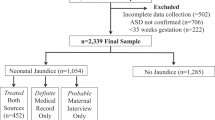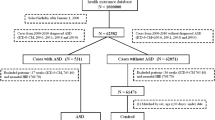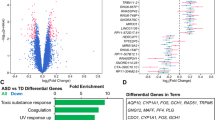Abstract
Neonatal jaundice has been suggested as a perinatal risk factor for autism spectrum disorder (ASD). We examined UGT1A1 polymorphisms to assess the potential of neonatal jaundice as a risk factor for ASD in children by using DNA extracted from preserved umbilical cord. In total, 79 children with ASD were genotyped for UGT1A1*28 (c.-41-40dup), UGT1A1*6 (c.211 G > A), and UGT1A1*27 (c.686 C > A). The allele frequency of UGT1A1*6 (OR = 1.34, p = 0.26) and UGT1A1*28 (OR = 0.80, p = 0.54) and the prevalence of UGT1A1*28/*6 diplotypes did not differ significantly from those in the control population. No UGT1A1*27 allele was detected in the subjects. ASD symptom assessment scores were not associated with UGT1A1*28/*6/*27 genotypes or UGT1A1*28/*6 diplotypes. These results suggest that neonatal jaundice is not significantly associated with ASD.

Similar content being viewed by others
References
Amin, S. B., Smith, T., & Wang, H. (2011). Is neonatal jaundice associated with autism spectrum disorders: A systematic review. Journal of Autism and Developmental Disorders, 41, 1455–1463. https://doi.org/10.1007/s10803-010-1169-6
Aoki, S., Hashimoto, K., Ikeda, N., Takekoh, M., Fujiwara, T., Morisaki, N., et al. (2016). Comparison of the Kyoto Scale of Psychological Development 2001 with the parent-rated Kinder Infant Development Scale (KIDS). Brain and Development, 38(5), 481–490. https://doi.org/10.1016/j.braindev.2015.11.001
Bosma, P. J., Chowdhury, J. R., Bakker, C., Gantla, S., De Boer, A., Oostra, B. A., et al. (1995). The genetic basis of the reduced expression of bilirubin UDP-glucuronosyltransferase 1 in Gilbert’s syndrome. The New England Journal of Medicine, 333(18), 1171–1175. https://doi.org/10.1056/nejm199511023331802
Cordero, C., Schieve, L. A., Croen, L. A., Engel, S. M., Maria Siega-Riz, A., Herring, A. H., et al. (2020). Neonatal jaundice in association with autism spectrum disorder and developmental disorder. Journal of Perinatology, 40, 219–225. https://doi.org/10.1038/s41372-019-0452-4
Croen, L. A., Yoshida, C. K., Odouli, R., & Newman, T. B. (2005). Neonatal hyperbilirubinemia and risk of autism spectrum disorders. Pediatrics, 115(2), e135–e138. https://doi.org/10.1542/peds.2004-1870
Dennery, P. A., Seidman, D. S., & Stevenson, D. K. (2001). Neonatal hyperbilirubinemia. The New England Journal of Medicine, 344(8), 581–590. https://doi.org/10.1056/nejm200102223440807
Froehlich-Santino, W., Tobon, A. L., Cleveland, S., Torres, A., Phillips, J., Cohen, B., et al. (2014). Prenatal and perinatal risk factors in a twin study of autism spectrum disorders. Journal of Psychiatric Research, 54, 100–108. https://doi.org/10.1016/j.jpsychires.2014.03.019
Grove, J., Ripke, S., Als, T. D., Mattheisen, M., Walters, R. K., Won, H., et al. (2019). Identification of common genetic risk variants for autism spectrum disorder. Nature Genetics, 51, 431–444. https://doi.org/10.1038/s41588-019-0344-8
Hikino, K., Ozeki, T., Koido, M., Terao, C., Kamatani, Y., Murakami, Y., et al. (2019). Comparison of effects of UGT1A1*6 and UGT1A1*28 on irinotecan-induced adverse reactions in the Japanese population: Analysis of the Biobank Japan Project. Journal of Human Genetics, 64, 1195–1202. https://doi.org/10.1038/s10038-019-0677-2
Hisle-Gorman, E., Susi, A., Stokes, T., Gorman, G., Erdie-Lalena, C., & Nylund, C. M. (2018). Prenatal, perinatal, and neonatal risk factors of autism spectrum disorder. Pediatric Research, 84, 190–198. https://doi.org/10.1038/pr.2018.23
Hongkaew, Y., Medhasi, S., Pasomsub, E., Ngamsamut, N., Puangpetch, A., Vanwong, N., et al. (2018). UGT1A1 polymorphisms associated with prolactin response in risperidone-treated children and adolescents with autism spectrum disorder. The Pharmacogenomics Journal, 18, 740–748. https://doi.org/10.1038/s41397-018-0031-7
Iossifov, I., O’Roak, B. J., Sanders, S. J., Ronemus, M., Krumm, N., Levy, D., et al. (2014). The contribution of de novo coding mutations to autism spectrum disorder. Nature, 515, 216–221. https://doi.org/10.1038/nature13908
Jenabi, E., Bashirian, S., & Khazaei, S. (2020). Association between neonatal jaundice and autism spectrum disorders among children: A meta-analysis. Clinical and Experimental Pediatrics, 63(1), 8–13. https://doi.org/10.3345/kjp.2019.00815
Kitaoka, T., Morimoto, M., Hashimoto, T., Tsuda, Y., Nakatsu, T., & Kyotani, S. (2020). Evaluation of the efficacy of drug treatment based on measurement of the oxidative stress, using reactive oxygen metabolites and biological antioxidant potential, in children with autism spectrum disorder and attention deficit hyperactivity disorder. Journal of Pharmaceutical Health Care and Sciences, 6, 8. https://doi.org/10.1186/s40780-020-00164-w
Kobayashi, M., Hazama, S., Takahashi, K., Oba, K., Okayama, N., Nishioka, M., et al. (2012). Is there diversity among UGT1A1 polymorphism in Japan? World Journal of Gastrointestinal Oncology, 4(7), 170–175. https://doi.org/10.4251/wjgo.v4.i7.170
Kupper, D. J., & Regier, D. A. (2013). Diagnostic and statistical manual of mental disorders (5th edn) (DSM-5). American Psychiatric Association.
Li, Z., Song, L., & Hao, L. (2020). The role of UGT1A1 (c.-3279 T > G) gene polymorphisms in neonatal hyperbilirubinemia susceptibility. BMC Medical Genetics, 21, 218. https://doi.org/10.1186/s12881-020-01155-2
Lord, C., Elsabbagh, M., Baird, G., & Veenstra-Vanderweele, J. (2018). Autism spectrum disorder. The Lancet, 392(10146), 508–520. https://doi.org/10.1016/s0140-6736(18)31129-2
Maeda, H., Hazama, S., Shavkat, A., Okamoto, K., Oba, K., Sakamoto, J., et al. (2014). Differences in UGT1A1, UGT1A7, and UGT1A9 polymorphisms between Uzbek and Japanese populations. Molecular Diagnosis and Therapy, 18, 333–342. https://doi.org/10.1007/s40291-014-0083-6
Maimburg, R. D., Bech, B. H., Vaeth, M., Moller-Madsen, B., & Olsen, J. (2010). Neonatal jaundice, autism, and other disorders of psychological development. Pediatrics, 126(5), 872–878. https://doi.org/10.1542/peds.2010-0052
Maimburg, R. D., Vaeth, M., Schendel, D. E., Bech, B. H., Olsen, J., & Thorsen, P. (2008). Neonatal jaundice: A risk factor for infantile autism? Paediatric and Perinatal Epidemiology, 22(6), 562–568. https://doi.org/10.1111/j.1365-3016.2008.00973.x
Mamidala, M. P., Polinedi, A., Rajesh, P. K. P. T., Vallamkonda, N., Udani, O. R., et al. (2013). Prenatal, perinatal and neonatal risk factors of Autism Spectrum Disorder: A comprehensive epidemiological assessment from India. Research in Developmental Disabilities, 34, 3004–3013. https://doi.org/10.1016/j.ridd.2013.06.019
Maruo, Y., Nakahara, S., Yanagi, T., Nomura, A., Mimura, Y., Matsui, K., et al. (2016). Genotype of UGT1A1 and phenotype correlation between Crigler-Najjar syndrome type II and Gilbert syndrome. Journal of Gastroenterology and Hepatology, 31(2), 403–408. https://doi.org/10.1111/jgh.13071
Maruo, Y., Nishizawa, K., Sato, H., Doida, Y., & Shimada, M. (1999). Association of neonatal hyperbilirubinemia with bilirubin UDP-glucuronosyltransferase polymorphism. Pediatrics, 103(6), 1224–1227. https://doi.org/10.1542/peds.103.6.1224
Monaghan, G., Ryan, M., Hume, R., Burchell, B., & Seddon, R. (1996). Genetic variation in bilirubin UDP-glucuronosyltransferase gene promoter and Gilbert’s syndrome. The Lancet, 347(9001), 578–581. https://doi.org/10.1016/s0140-6736(96)91273-8
Sakamoto, A., Moriuchi, H., Matsuzaki, J., Motoyama, K., & Moriuchi, M. (2015). Retrospective diagnosis of congenital cytomegalovirus infection in children with autism spectrum disorder but no other major neurologic deficit. Brain and Development, 37(2), 200–205. https://doi.org/10.1016/j.braindev.2014.03.016
Schaaf, C. P., Betancur, C., Yuen, R. K. C., Parr, J. R., Skuse, D. H., Gallagher, L., et al. (2020). A framework for an evidence-based gene list relevant to autism spectrum disorder. Nature Reviews Genetics, 21, 367–376. https://doi.org/10.1038/s41576-020-0231-2
Schopler, E., Reichler, R. J., Devellis, R. F., & Daly, K. (1980). Toward objective classification of childhood autism: Childhood Autism Rating Scale (CARS). Journal of Autism and Developmental Disorders, 10, 91–103. https://doi.org/10.1007/bf02408436
Seo, J. Y., Lee, J.-E., Chung, G. E., Shin, E., Kwak, M.-S., Yang, J. I., et al. (2020). A genome-wide association study on liver enzymes in Korean population. PLoS ONE, 15(2), e0229374. https://doi.org/10.1371/journal.pone.0229374
Solomon, M., Iosif, A.-M., Reinhardt, V. P., Libero, L. E., Nordahl, C. W., Ozonoff, S., et al. (2018). What will my child’s future hold? Phenotypes of intellectual development in 2–8-year-olds with autism spectrum disorder. Autism Research, 11(1), 121–132. https://doi.org/10.1002/aur.1884
Soorani-Lunsing, I., Woltil, H. A., & Hadders-Algra, M. (2001). Are moderate degrees of hyperbilirubinemia in healthy term neonates really safe for the brain? Pediatric Research, 50, 701–705. https://doi.org/10.1203/00006450-200112000-00012
Takahashi, N., Harada, T., Nishimura, T., Okumura, A., Choi, D., & Iwabuchi, T. (2020). Association of genetic risks with autism spectrum disorder and early neurodevelopmental delays among children without intellectual disability. JAMA Network Open. https://doi.org/10.1001/jamanetworkopen.2019.21644
Taniguchi-Ikeda, M., Takeshima, Y., Lee, T., Nishiyama, M., Awano, H., Yagi, M., et al. (2016). Next-generation sequencing discloses a nonsense mutation in the dystrophin gene from long preserved dried umbilical cord and low-level somatic mosaicism in the proband mother. Journal of Human Genetics, 61, 351–355. https://doi.org/10.1038/jhg.2015.157
Wang, J., Yin, J., Xue, M., Lyu, J., & Wan, Y. (2020). Roles of UGT1A1 Gly71Arg and TATA promoter polymorphisms in neonatal hyperbilirubinemia: A meta-analysis. Gene, 736, 144409. https://doi.org/10.1016/j.gene.2020.144409
Watchko, J. F., & Tiribelli, C. (2013). Bilirubin-induced neurologic damage: Mechanisms and management approaches. The New England Journal of Medicine, 369, 2021–2030. https://doi.org/10.1056/nejmra1308124
Acknowledgments
We thank all staffs of the participating centers and hospital for collecting preserved dried umbilical cord samples. This study was supported in part by Grants-in-Aid for Scientific Research (KAKENHI) from the Ministry of Education, Culture, Sports, Science and Technology of Japan (Grant No. 17K16299 to KM). The present study was approved by the ethics committee at Kobe University Graduate School of Medicine (No. 170002).
Author information
Authors and Affiliations
Contributions
TH contributed to the design of the study, performed data collections and statistical analyses, and wrote the original draft. KM contributed to the design of the study, performed sample collections, and edited the original draft. MN, MM, YT, YO, TK, MN, YK, MY, HM, YN, JS, SF, KF, and KT performed sample and data collections. ST, HN, KN, and KI contributed to the design of the study and edited the manuscript. NN contributed to the design of the study, performed sample collections, and edited the original draft. All authors participated in the preparation of the manuscript and approved its final version.
Corresponding author
Additional information
Publisher's Note
Springer Nature remains neutral with regard to jurisdictional claims in published maps and institutional affiliations.
Supplementary Information
Below is the link to the electronic supplementary material.
Rights and permissions
About this article
Cite this article
Horinouchi, T., Maeyama, K., Nagai, M. et al. Genetic Analysis of UGT1A1 Polymorphisms Using Preserved Dried Umbilical Cord for Assessing the Potential of Neonatal Jaundice as a Risk Factor for Autism Spectrum Disorder in Children. J Autism Dev Disord 52, 483–489 (2022). https://doi.org/10.1007/s10803-021-04941-w
Accepted:
Published:
Issue Date:
DOI: https://doi.org/10.1007/s10803-021-04941-w




